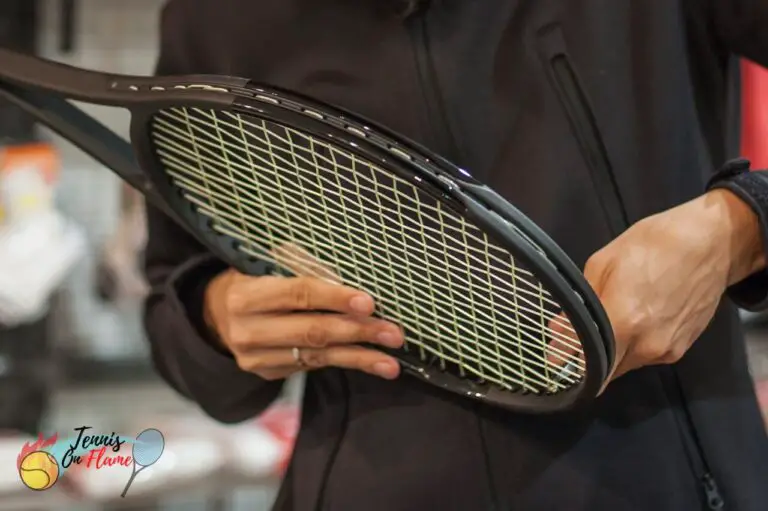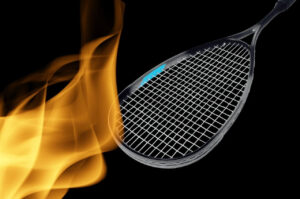It can be a challenge to string a tennis racket without a machine.
There are many ways to do it, and not all of them will work for everyone.
In this blog post, we will provide an informative guide on how to string your tennis racket using common household items.
We will also provide tips on how to make the process easier and more efficient.
Are you ready to string your tennis racket? Let’s get started!
How to String a Tennis Racket Without a Machine – a step-by-step guide
The first step is to gather the necessary supplies:
You will need a tennis racket, some string, scissors, and a needle.
If you want to add tape or grips to your racket, you will also need those items.
Once you have gathered all of the supplies, it’s time to get started:
The first step is to string a tennis racket is to cut the string.
You will need about 18 inches of string, so you can use a tape measure or ruler to measure it.
Once you have measured the string, use scissors to cut it.
Next, you will need to tie a loop at one end of the string.
This loop will be used to hold the racket while you are stringing it.
The next step is to tie a knot on the other end of the string.
This knot will keep the string from slipping through the needle’s eye.
Now it’s time to start stringing your tennis racket!
The first step is to put the tennis racket in the loop.
The knot should be facing away from the racket.
Next, use the needle to poke a hole in the grip of the racket.
Make sure that you are poking it in the right spot – you should be aiming for the center of the grip.
Once you have poked the hole, use the needle to put the string through it.
Pull the string all the way through until it is tight against the grip.
Now it’s time to tie a knot in the string.
The best way to do this is to hold onto both ends of the string and twist it together like you would a piece of rope.
Make sure that the knot is tight against the grip.
The next step is to cut off any excess string.
You can do this by holding onto the string and using scissors to cut it off flush with the knot.
Repeat these steps until you have strung all of the strings on your tennis racket.
When you are finished, it’s time to test out your new racket!

Tips for Stringing a Tennis Racket Without a Machine
Here are some tips for stringing a tennis racket without a machine:
– If the knot is loose, use pliers to tighten it up.
– Make sure that the knots are tight against the grip – this will help to prevent them from slipping.
– If you have trouble poking a hole in the grip, try using a sharp knife or a nail instead of a needle.
– You can also use dental floss or a fishing line to string your tennis racket – these items are thin and easy to work with.
– If you are having trouble getting the string through the hole, try using a crochet hook or a chopstick.
– When cutting the string, make sure to cut it flush with the knot – this will help to prevent fraying.
Stringing a tennis racket without a machine can be challenging, but with practice, you will be able to do it like a pro! Have fun and good luck.
Benefits of stringing a tennis racket without a machine
There are several benefits of stringing a tennis racket without a machine:
– It is cheaper than using a machine.
– You can customize the tension and thickness of the strings to your liking.
– It is a great way to learn about how tennis rackets are strung.
Drawbacks of stringing a tennis racket without a machine
There are also some drawbacks to stringing a tennis racket without a machine:
– It can be difficult and time-consuming.
– The knots can loosen over time, which can lead to the strings slipping out of place.
– There is a higher risk of breaking the strings.
– It is not as precise as using a machine.
Can I restring a tennis racket at home?
Yes, you can restring a tennis racket at home – it is a challenging but rewarding process.
If you are new to string, be sure to read the instructions carefully and practice on an old racket before moving on to your actual game-day racquet.
How hard is it to string a tennis racket?
It can be hard to string a tennis racket without a machine, but with practice, you will get the hang of it.
The most challenging part is poking the hole in the grip and getting the string through it – but once you have mastered this skill, the rest is easy.
Is there an easier way to string a tennis racket?
There is an easier way to string a tennis racket – you can use a machine.
If you are not comfortable or experienced enough to string a tennis racket without a machine, then I recommend using one. It will make the process much simpler and less frustrating.
How often should I restring my tennis racket?
Most professional tennis players restring their tennis rackets twice a year.
However, this may vary depending on how often you play, the tension of the strings, and the type of racket that you are using.
It is a good idea to inspect your tennis racket regularly for any signs of wear and tear, and if you notice anything wrong, then consider restringing it.
How much string Do I need to string a tennis racquet?
You will need approximately 20 feet of string to string a tennis racquet.
This may vary depending on the size and make of your tennis racket.
If you are unsure, it is best to buy more than you think you will need – it is always better to have too much than not enough.
What type of string should I use to string my tennis racquet?
There are many different types of string available on the market, and it can be tricky to decide which one is right for you.
I recommend using a synthetic gut or polyester string – these options provide good durability and playability.
How do I know if my tennis racket is strung too tight or too loose?
If your tennis racket is strung too tight, you will notice that it feels stiff and uncomfortable to play with.
On the other hand, if your tennis racket is strung too loose, it will feel floppy and unresponsive.
It is important to find the right balance so that your racket feels comfortable and gives you the best performance possible.
What tension should my tennis strings be?
The tension of your tennis strings depends on your personal preference.
Some players prefer a higher tension, while others prefer a lower tension.
It is important to experiment until you find the right setting for you.
How can I make my tennis racket stronger?
There are a few ways that you can make your tennis racket stronger:
– Use a harder string material, such as gut or kevlar.
– Increase the tension of the strings.
– Make sure that the frame is in good condition and has no cracks or chips.
How long does it take to learn to string a tennis racket?
It takes time and practice to learn how to string a tennis racket without a machine.
The most important thing is to be patient and take your time. With some patience and perseverance, you will be able to do it!
How do you string a tennis racket fast?
There is no one definitive way to string a tennis racket fast.
Some people prefer to use a machine, while others do it by hand.
It all comes down to personal preference and what works best for you.
What are the benefits of restringing my tennis racket?
The main benefit of restringing your tennis racket is that it will improve your performance on the court.
If your racket is not performing well, then consider restringing it to see if that makes a difference.
Another benefit of restringing your tennis racket is that it will prolong the life of your racquet.
By regularly inspecting and maintaining your racquet, you can ensure that it lasts for many years.
In conclusion,
There are many benefits to restringing your tennis racket. If you are not happy with the performance or feel of your racquet, then consider giving it a fresh new string job!
You can do it at home without a machine – it just takes a bit of practice and patience.
Or, if you feel uncomfortable doing it yourself, take it to a professional stringer and they will be happy to help. that’s what I’m doing personally as a tennis player.
Whatever you do, just make sure that you keep your racquet in good condition and give it a new string job now and then!
Believe me, It will make a big difference to your game.









One Response
Greetings! Very helpful advice within this article! It’s the little changes that will make the greatest changes. Thanks a lot for sharing!